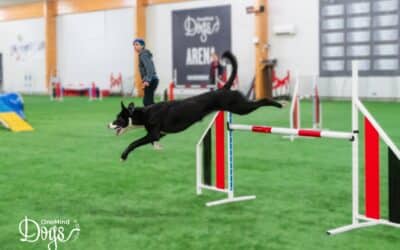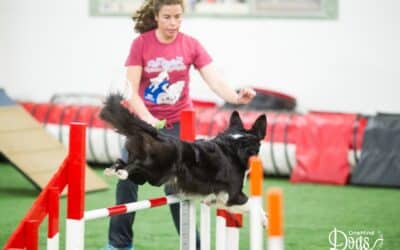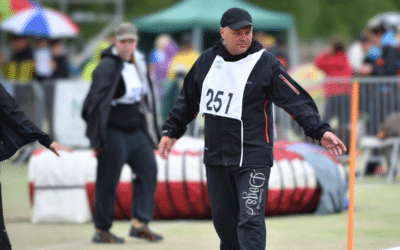Hey there, fellow agility addicts! Are you ready to teach your dog some awe-inspiring weave pole skills? One of the most important and fun (although sometimes, frustrating!) parts of agility training is mastering the weave poles. So, buckle up as we guide you through five easy-peasy steps to achieve fantastic, independent weaves with your pup. And don’t forget to sign up for our free webinar, where we’ll explore these topics in even greater detail!
1. Foundations: Starting off with solid weave foundation skills
A thorough foundation is the secret to successful weave pole training. It’s like creating a strong base for your dog to build on as they continue their agility career. In this section, we’ll check out some cool training methods and discover why offering and rewarding are super important for your dog’s training.
Weave pole training methods
There are several ways to teach your dog how to conquer those weave poles. Each method has its perks, so feel free to explore and see which one clicks best with your dog. Just remember that the aim is independent weave poles, so make sure you choose a method that doesn’t require you to stay beside your dog. At OneMind Dogs we use a combination of methods to cater for individual dogs. Here are the most popular methods:
1. 2×2 weaves: This method uses 6 sets of two poles. Once you teach your dog to LOVE the two poles, you add another set, placed at a wide angle at first. As your dog starts to get the hang of it, you can gradually bring the poles closer together and add more sets to increase the challenge.
2. Channels: With channel training, you create a runway for your dog by placing the poles in parallel rows. Over time, you’ll move the poles closer together, encouraging your dog to weave through the narrow path. Channels are often a good motivator for lower-drive dogs!
3. Guide wires: These handy wires are attached to the weave poles, creating a visual guide for your dog to follow. As your dog becomes a weaving pro, you will gradually fade the wires until your dog can easily do without, just like training wheels on a bike!
4. Weave-o-matics: This adjustable equipment lets you easily change the angle of the poles to make it simple for your dog to understand how to move through the weaves. It helps your dog gradually learn the weaving action as you tweak the setup to make it trickier as they progress.
Offering the weaves
Weave offering is a fantastic technique that encourages your dog to tackle the weave poles all by themselves right from the start, rewarding their can-do attitude. This approach helps your dog get super excited about the task while building their confidence and independence. See some examples in our free webinar!
To make offering work, start by rewarding your dog for showing interest in the weave poles. Slowly up the ante by expecting them to complete more of the weaving action before dishing out rewards. In no time, your dog will be eager to tackle the weave poles like a pro!
Rewarding the weaves
Strategically delivered rewards are an essential ingredient in foundation training and the key to achieving independent weaves, as they reinforce your dog’s positive behavior, increase value for the weave poles and keep motivation high. When rewarding your dog during weave pole training, keep these things in mind:
- Value: Use only the best rewards that your dog can’t resist. It could be their favorite treats or toys. The more irresistible the reward, the more your dog will want to show off their weaving skills.
- Timing: Be quick on your toes with those rewards. Aim to reward your dog as soon as they complete the weave poles or show the desired action during training. This instant reinforcement helps your dog connect the reward with their behavior.
- Placement: Be smart with reward placement during training. Put the reward where the next weave pole would be or somewhere that encourages your dog to keep up its weaving momentum and not focus on you while weaving.
- Praise: Don’t forget to shower your dog with praise during training. Happy words and lots of pats help reinforce their love for the weave poles and keep them excited about the task.
See some examples in this video from our Independent Weaves Guided Course:
2. Weave entries: Starting your weaves with a bang
Teaching your dog to tackle tricky weave entries independently is crucial in weave pole training. Practice different angles and positions to help your dog figure out how to find the right entry point to the weave poles. This way, they’ll be ready to rock those poles with confidence during agility competitions.
Tools like guide wires and nets and placed rewards can be a big help in guiding your dog to the right entrance to the weave poles. These aids steer their path, manage their speed, and provide support as they begin their weaving adventure.
3. Weave exits: Staying committed and nailing the finish
Training different exits is just as important as entrances in weave pole training. Make sure to teach your dog how to handle various exits and different types of handling. This will help them adapt to different course setups and ensure a smooth transition to the next obstacle during competitions.
A key factor in successful exits is staying connected with your dog as they complete the weave poles. This connection helps prevent them from leaving the poles too soon and ensures they understand their next move. Techniques like the chest laser or well-timed front and blind crosses can offer valuable support during exits.

4. Distractions: Turning your dog into a focus master
The next step is introducing distractions during weave pole training to turn your dog into a focus master, ensuring it keeps its cool in challenging or high-pressure situations. This section will discuss the importance of distraction training, how to slowly introduce distractions and the perks of proofing your dog’s performance against various distractions.
In agility competitions and everyday life, your dog will encounter various distractions that could throw them off its game. By adding distractions to your training, you help your dog develop the mental toughness and focus needed to stay on track, no matter what’s happening around them.
Introducing distractions step by step
When adding distractions to your weave pole training, start small and gradually increase the difficulty. Begin with mild distractions, like someone clapping or a toy rolling nearby. As your dog gets the hang of handling these distractions, up the ante by introducing more challenging distractions, like other dogs running close by or loud noises.
Be patient and supportive during this process, offering praise and rewards for your dog’s successful completion of the weave poles despite the distractions. This will reinforce their positive behavior and encourage them to stay focused on the task at hand.
5. Distance: Teaching your dog to weave like a pro
In agility competitions, you might need to be at a distance from your dog as they navigate the weave poles due to various factors like course design, your physical abilities, or strategic handling decisions. Adding distance training to your weave pole practice ensures your dog can confidently and skillfully tackle the poles even when you’re not beside them.
When working on distance training, start slowly and gradually increase the space between you and your dog. Begin with your dog weaving while you’re just a few steps away and reward them on the ground after the weaves rather than from your hand. You can progressively increase the distance as they become more comfortable and skilled.
To help your dog build confidence and focus on the weave poles, use tools like nets, guide wires, and well-timed rewards during distance training.
Check out these amazing weave skills from OneMind Dogs Instructor Stephanie Williams and her dog Dash:
Join our Guided Course today: Let’s Get Weaving!
Now that we’ve covered the five fantastic steps to achieving wonderful weaves in agility, it’s time to put these ideas into action.
Sign up for our free webinar today to supercharge your weave pole training and then join our guided course with Stephanie by filling out the form below. We’ll explore these topics and more, giving you expert tips and guidance to become a weave pole training wizard.


